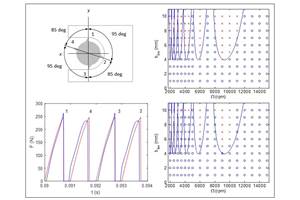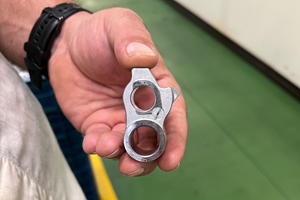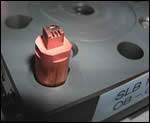Handle With Care
Micro-size drills and end mills don鈥檛 have to be difficult to use.
Share






It may seem strange that a tool able to cut metal can be so fragile that just setting it down on the bench too firmly can break it. But this is true of the smallest commercial drills and end mills used to produce machined features in small parts such as medical components. These tools demand process considerations all their own in order to use them effectively, and gentle handling is a primary consideration.
Niagara Cutter (Amherst, New York) is among the cutting tool companies that offer a line of micro-size tools. When using a 0.005-inch-diameter end mill, says Niagara engineering manager Dennis Noland, "just touching the tool with your hand the wrong way can break it."
Welcome! You鈥檝e unlocked premium content.
And yet, a disciplined machine shop can use these tools quite well. The gentle handling outside the cut simply has to continue on into the cut as well. Even light impacts have to be avoided鈥攎eaning, for example, that non-contact tool measurement should be used鈥攁nd runout and vibration need to be tightly controlled.
"TIR [total indicator reading] becomes critical," Mr. Noland says. The spindle and toolholder have to center the tool within a narrow band of concentricity. While a TIR measurement of 0.0005 inch might seem fussy in other applications, even that much runout becomes large when the tool diameter itself is only around 0.020 inch. The maximum acceptable runout is likely to be no more than 0.0002 inch, and maybe as small as half that size.
Such an exacting concentricity requirement does call for a quality toolholder, but it does not necessarily call for a specialized toolholder. These small-diameter tools typically have 1/8-inch shanks, so standard toolholders can grip them. A collet toolholder can work, and shrink fit may be better still.
What's Fast Is Slow
The next consideration is speed. Even an otherwise reasonably fast spindle鈥攕ay, 12,000 rpm鈥攚ill confine a small-diameter tool to a painfully low cutting speed. For example, put a 0.020-inch tool in such a spindle and the top cutting speed is just 63 sfm.
Mike Tibbet is a senior development engineer for micro cutting tool maker Kyocera Tycom (Irvine, California). He says one way to get the small milling and drilling tools up to speed is by adopting an add-on high speed spindle for the sake of these tiny tools. Because torque demands are small, the spindle can be air-powered. Alternatively, a motorized add-on spindle can permit machining of harder metals. Mr. Tibbet typically recommends a spindle speed of 80,000 rpm.
Spindle runouts, along with the general rigidity and tightness of the machine tools, are among the characteristics shops should look at when they are considering micro tools on their equipment, he says. Another important consideration is the coolant filtration, and the level of coolant cleanliness the shop can typically maintain. Small particles in the coolant can deliver relatively large impacts to micro-size tools.
For committed users, Mr. Tibbet also recommends a camera with a zoom lens to monitor the process. Because the micro tools make no audible sound when they're cutting and can't be seen cutting with the unassisted eye, these tools are problematic to troubleshoot. If a mistake causes a tool to break, the shop might be doomed to continue making that same mistake again and again. But a camera with some magnification can allow the machining to be observed as if it involved a standard-size cutter. "The idea is, if you magnify it enough, then it's not 鈥榤icro' anymore," Mr. Tibbet says.
Laying It On Thick
Not everything is so scalable. Niagara's Mr. Noland is careful to point out one performance-enhancing feature of modern cutting tools that generally can't be applied to tools at micro-scale: the coating.
"We generally don't supply coating on these tools unless it's specifically requested," he says.
The reason relates to geometry. The thickness of a layer of PVD coating may be negligible on a standard-size tool, but that thickness becomes significant when the tool is just 0.010 inch in diameter. The layer of coating rounds the cutting edge. Because the rounded edge is prone to rub, coating at this scale is likely to impede the tool's performance instead of helping it.
Deep Hole Drilling
The ability to machine deep holes with small-diameter tools is improving, says Kyocera Tycom's Mike Tibbet. In one application, the company developed a 0.020-inch-diameter drill to machine a hole 0.750 inch deep in titanium.
Heat is a challenge in such an application, he says. In micro machining in general, the phenomenon of the heat leaving the cut with the chip (an effect that most machining processes try to take advantage of) simply cannot be realized, because the chip is not large enough. The heat goes into the tool instead, and the process has to allow for this.
The solution in micro drilling is a time-tested drilling technique: the peck cycle. The drill is frequently removed from the hole and allowed to dwell for a second or so鈥攋ust long enough to give the coolant time to cool it down.
Deep Slot Milling
Not all small-diameter tools are used on small parts. Some are used on small features of bigger parts, such as the deep slots in molds that might otherwise be produced through EDM.
Cutting tool maker OSG Tap & Die (Glendale Heights, Illinois) makes end mills specifically for this application. According to engineering manager David Kwon, reconciling rigidity and chip clearance is the principal design challenge of this type of tool. He says the particular micro-grain carbide used for the tool is part of what makes the compromise possible.
As the length-to-diameter ratio for a small-slot milling tool increases, the risk of deflection increases as well. For this reason, Mr. Kwon recommends using a sequence of tools for a deep slot. For example, tools of three different lengths might be used on a particularly deep slot. The shorter and stiffer tools can take more aggressive rough cuts. Then, only the deepest reaches of the slot need to be machined using the lighter parameters that are necessary to guard the longest tool against deflection.
Related Content
The Impact of Cutting Teeth Spacing on Machining Stability
Many cutter designs are available, and variable teeth spacing (or variable pitch) cutters can be used to influence milling stability. Let’s discuss why teeth spacing affects stability.
Read MoreMeasuring Torque, Thrust Force for Smart Drilling Operations
To monitor drilling operations for smart manufacturing solutions, torque and thrust force can be measured.
Read MoreIndexable Drill Heads Double Profitability
Moving to a robust line of indexable drills enabled this shop to dramatically alter the manufacturing process for a problem part, doubling its profitability.
Read MoreCustom PCD Tools Extend Shop’s Tool Life Upward of Ten Times
Adopting PCD tooling has extended FT Precision’s tool life from days to months — and the test drill is still going strong.
Read MoreRead Next
Molds In Miniature
A shop that makes tooling for metal injection molding (MIM) relies on a machining center designed specifically for micro-scale work.
Read MoreMeasuring Surface Roughness in the Machine Tool
As tooling wears, surface finish will be affected, and thus, it becomes critical to measure a part’s surface finish regularly — or in the manufacture of very critical components, every part.
Read MoreHow I Made It: Dennis Rymanowski
Dennis Rymanowski has worked at NSH USA for 60 years, with his passion for manufacturing living alongside his passion for his family’s polka band.
Read More





















